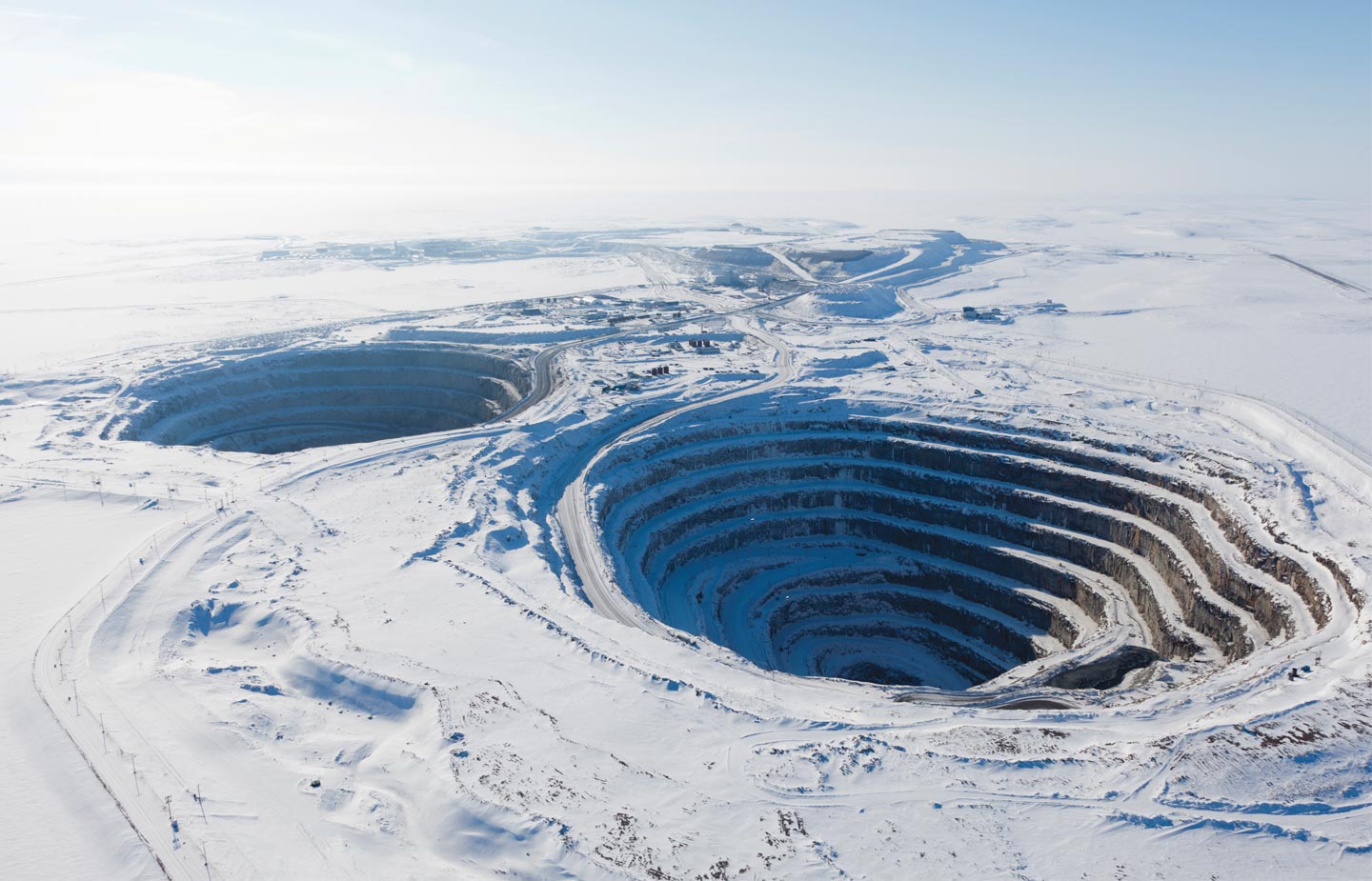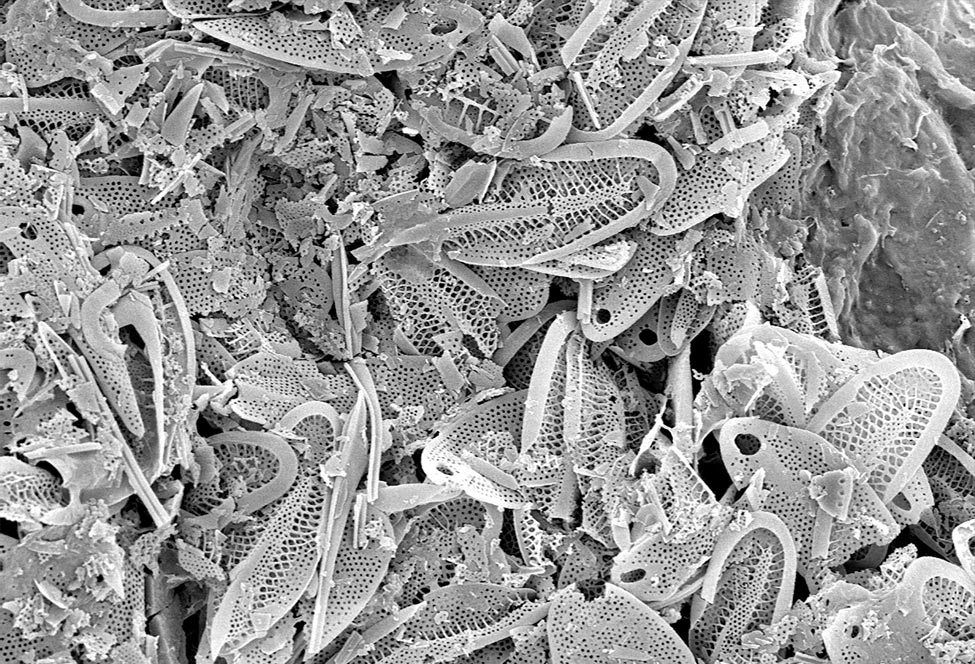The Giraffe Locality
Global warming may turn Arctic ice caps into tropical lakes. To look into the future, Professor Peter Siver turns to clues from the past.
Peter Siver doesn’t much care for diamonds.
The botany professor is far more interested in microscopic algae—diatoms and chrysophytes—that live in lakes, oceans and other waterways.
But sometimes, diamonds are a researcher’s best friend. And near the Arctic Circle, sometimes the search for these precious stones uncovers the remains of an undiscovered ancient lake.
In the late 1990s, BHP Billiton, an Australian-based mining company, was drilling for diamonds in one of the northernmost regions of Canada’s Northwest Territories. The company was digging 400 feet into the tundra in search of kimberlite pipes, vertical cylinders in the Earth’s crust that can push the rocks that sometimes contain diamonds from deep within the mantle to the earth’s surface.
BHP was extracting sample cores of sediment from what was once a large crater, likely produced by the violent volcanic eruption that occurs when the highly molten material from which diamonds are formed moves up in the kimberlite cylinder.
Where there are kimberlites, there are often diamonds, so “if the sample didn’t contain enough diamonds to warrant mining, they’d just dump it,” says Siver, the Charles and Sarah P. Becker ’27 Professor of Botany and director of the Environmental Studies Program at Connecticut College.
One castaway core didn’t contain diamonds. However, the remains of an ancient lake that had once filled the crater were ever-present. To Siver, a sample like this is pure gold, because by analyzing the billions of microfossils left behind, he can piece together the past and help predict the future of our polar ice caps.
A sliver of this dirt can hold thousands of tiny algae fossils, including diatoms and chrysophytes. By studying the remains of these microbes, each of which thrive under different circumstances, Siver can reconstruct the evolution of the lake and of the organisms themselves.
In 2005, Siver began working on one of the BHP Billiton cores with Alexander Wolfe, a professor of paleobiology at the University of Alberta. They dubbed the sample site the “Giraffe locality” and determined the lake had formed 48 million years ago, in the middle Eocene “hothouse” period. It lasted for thousands of years before slowly turning into a marsh, then a bog, then forested land and finally the frozen tundra it is today.
The fossils in the sample are fantastically preserved—a treasure trove of scientific information. But collecting all that information isn’t easy. The whole core sample stretches the length of 1.63 football fields; chrysophytes and diatoms can’t be seen by the naked eye.
“It’s like looking for a needle in the ocean,” Siver says.
To conduct the research, Siver and Wolfe secured two grants from the National Science Foundation totaling more than $675,000. Over the past 12 years, they’ve led a growing team of scientists on a mission to find out just what this ancient lake can tell us about climate change and global warming.
UNDER THE MICROSCOPE
Siver is a scientist, but he’s also a detective of sorts. He looks for clues, collects evidence. No detail is too small.
He’s one of the best in the world at what he does: Siver is the author of more than 140 peer-reviewed articles, four books and two edited volumes. He has discovered more than 80 new species of chrysophytes and diatoms, and even several new genera. He has also developed innovative ways of working with light and electron microscopes to reveal new details about the smallest of organisms.
Sometimes, even real detectives seek him out. Siver has helped solve murder cases by analyzing the diatoms in mud samples found on shoes to determine the source of the mud. One such case was the basis of an episode of Forensic Files.
In the arctic, though, what he found was tropical.
Looking at the samples under an electron microscope, Siver found chrysophytes species that today inhabit wetlands, small lakes and ponds. He also found warm-water sponges and tropical diatoms, including several species from the genus Actinella, whose closest modern relatives are found in Australia. Finding any diatoms at all was a surprise, since they had only started to invade freshwater bodies at the time the lake was formed.
“It might be one of the earliest freshwater diatom sites on the planet,” Siver says.
It was all proof that this area of northern Canada had once been warm.
But how warm?
ARCTIC PALM TREES
As Siver set to work identifying and describing more of the organisms, a microscopic mystery emerged.
Again and again, he came across a round object covered with spikes. In his notes, he referred to the object as a Christmas ornament, since it reminded him of a decoration that might hang from the tree.
He found thousands of them, sometimes in a near-perfect line. He had no idea what they were.
Then, by chance, he happened upon a tiny picture of the same spiky ball in a Nature article about the evolution of herbivores and the spread of grasslands. The caption identified it as a phytolith, or silicified particle of plant tissue. From a palm tree.
“Palm trees in the arctic,” Siver says. “Imagine that. It’s fantastic evidence that there couldn’t have been any ice” when the lake thrived.
To get an even better understanding of the climate, Siver and Wolfe enlisted a bigger group of researchers on a study to determine the area’s average temperature, annual precipitation and atmospheric levels of carbon dioxide. The results were recently accepted for publication in Geology, a top scientific journal.
Using fossilized pollen, the scientists calculated that the area was more than 17 degrees Celsius (or approximately 30 degrees Fahrenheit) warmer than it is today, and significantly wetter.
The modern-day climate equivalent: Nashville, Tennessee.
“Amazingly, that’s also right about where palm trees stop growing,” says Siver.

